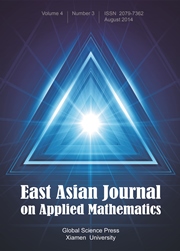Article contents
3-D Numerical Simulations of Biofilm Flows
Published online by Cambridge University Press: 28 May 2015
Abstract
We study the biofilm-flow interaction resulting in biofilm growth and deformation in a water channel in a 3-D setting using the phase field model developed recently. In this biofilm model, the biofilm made up of the EPS, bacteria and solvent is tracked using a biofilm volume fraction which vanishes outside the biofilm region. The interface between the biofilm and the solvent is marked by the zero level surface of the volume fraction measured from the biofilm to the solvent. The growth of the biofilm and the solvent-biofilm interaction with the top nutrient feeding condition is simulated in the viscous regime (growth regime) of the biofilm-solvent mixture flow. In quiescent flows, the model predicts growth patterns consistent with experimental findings for single or multiple adjacent biofilm colonies, in which the known mushroom shape growth pattern is obtained. Shear induced deformation in biofilms is simulated in a shear cell, providing a viable numerical evidence for using simulation tool to study biofilm growth and interaction dynamics in aqueous environment.
Keywords
- Type
- Research Article
- Information
- Copyright
- Copyright © Global-Science Press 2011
References
- 8
- Cited by


